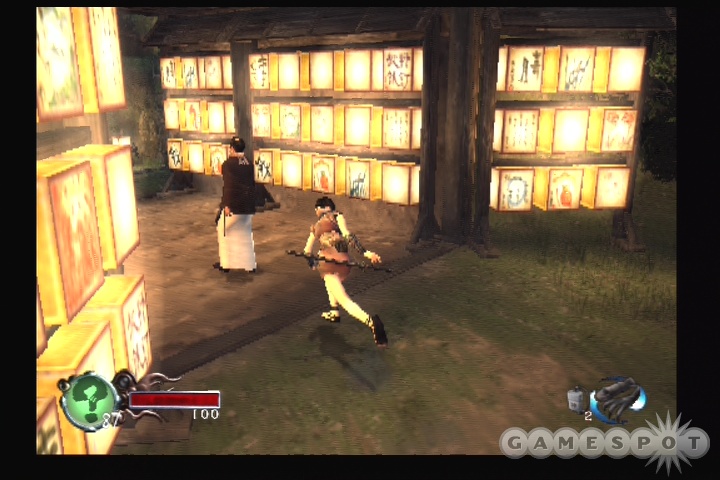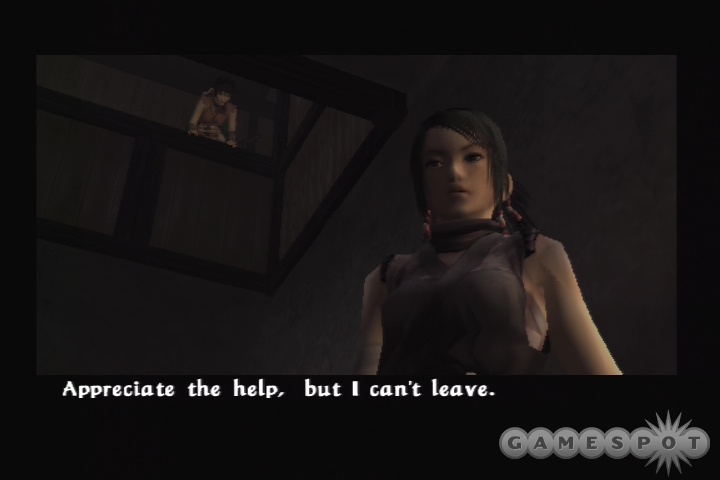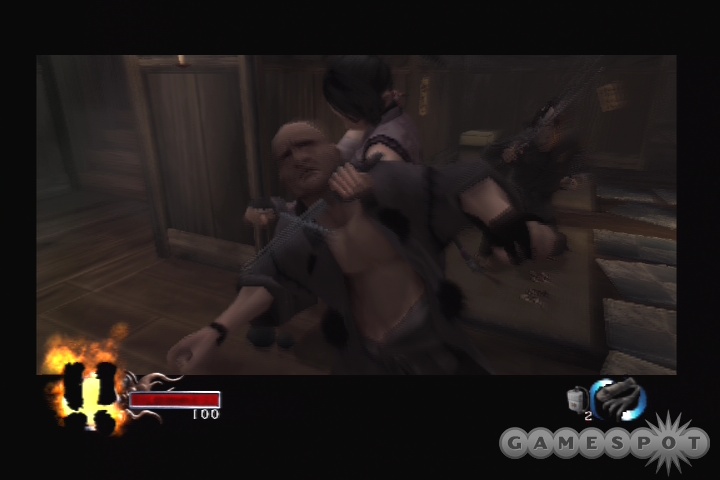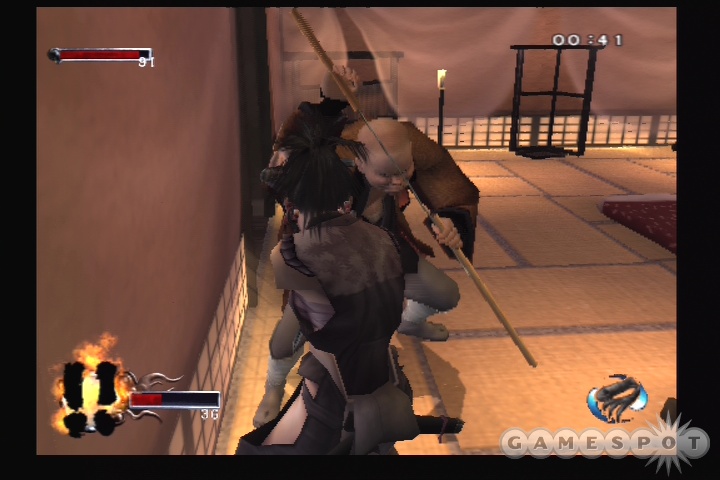It's been a good couple of years since Tenchu's last (and first) outing on the PlayStation 2. Ready for more? This seminal stealth action series, whose publishing rights recently changed hands from Activision to Sega and From Software, actually hasn't changed much at all since its last jaunt. The latest installment, Tenchu: Fatal Shadows, offers an experience that's going to be very familiar to those acquainted with the series and its signature-style killing and grappling-hook swinging, despite an original story and a new playable character. As for those who've never played one of these ninja simulators before, at this point they're unlikely to get past the clunky controls, numbingly dumb enemies, and dated presentation to appreciate what Tenchu has to offer. Make no mistake: Everything that's ever been good about this series is pretty much intact in Fatal Shadows. But, as if through stubborn adherence to tradition, Tenchu just hasn't evolved with the times. As a result, you'll need to keep a sharp lookout to spot this game's strong traits.

Like its predecessors, Fatal Shadows takes place in medieval Japan and portrays ninjas in a relatively realistic light. These aren't the superhuman, ultrafast warriors like Ryu Hayabusa from last year's Ninja Gaiden. They're relatively fragile but versatile assassins whose greatest strengths lie in their abilities to both stay out of sight and quickly, cleanly kill anyone unaware of their collective presence. The story of Fatal Shadows doesn't assume your familiarity with previous Tenchu games, but those who've played one of the past installments will immediately recognize Ayame, one of the two main characters. This pretty ninja girl once might have seemed like a young and inexperienced killer, but in Fatal Shadows, that part goes to Rin...a young and inexperienced killer who crosses paths with Ayame when Ayame shows up to investigate a village that's been put to the torch. As one of the only survivors of this assault, Rin swears an oath of vengeance and sets off on a blood-soaked journey to slay her village's attackers. She'll join forces with Ayame during the course of Fatal Shadows' story, in which the two will follow through on their plans to seek retribution, one life at a time.
You'll alternate playing as Ayame and Rin, but they aren't drastically different characters. Ayame is a little older and a little wiser, and she uses two short blades to do her dirty work, whereas Rin sports one long, deadly sword that's strapped to her back. It's probably fitting that these two girls have a lot in common, since they play pretty much identically, too. Each one can execute different types of attack combos and stealth kills, but the way you execute these moves is the same in both cases. Neither character is particularly quick on her feet, but each can double-jump and use a grappling hook to latch onto ledges and rooftops and such. The grappling hook used to be one of Tenchu's unique gameplay conventions, but the mechanic really hasn't changed since it was introduced in 1998. Therefore it's not much of a novelty anymore. For that matter, it's harder than ever to make excuses for Tenchu's awkward camera and control issues. The camera will automatically shift as you approach ledges, which is great for when you're trying to get the drop on a foe beneath you but is not so great on most other occasions. Meanwhile, the same button used for crouching is used for flattening your back against walls, so you'll find yourself accidentally switching between these two postures frequently while in narrow corridors. It's certainly possible to compensate for these kinds of annoyances, but ideally you shouldn't have to.

Tenchu: Fatal Shadows consists of a series of linear missions that challenge you to sneak up on your enemies and then kill them. This is done simply by running up to a foe whose back is turned and pressing the attack button when in striking distance. You'll then be treated to a brief, fancy-looking stealth kill animation, which changes depending on your angle of approach. It's even possible to simultaneously stealth-kill two nearby foes this time, though circumstances rarely allow it. Anyway, all the stealth kills look pretty good, but they're relatively not as impressive or as shocking as they once seemed, so they're not the great reward they used to be. Of course, there's more to Fatal Shadows than nonstop backstabbing, though.
If you're spotted by an average foe, it's usually possible to duke it out using a small variety of basic attacks. Yet it's often easier to run around the nearest corner to wait a little while, causing your foe to completely forget about you. Since all of them forget after the same interval, the game's sense of suspense wears quite thin. As in the previous games, the enemy artificial intelligence in Tenchu: Fatal Shadows is clearly designed to mitigate the necessity of pure trial and error, since it usually lets you retreat and regroup. But it's simply not believable. Even longtime Tenchu fans will probably find the opposition in Fatal Shadows a tough pill to swallow, because the game recycles many of the same animations as its predecessors, and the AI still mostly just patrols back and forth in a completely predictable fashion.

In addition to all the sneaking and slicing, Fatal Shadows includes a number of unavoidable head-on confrontations with boss opponents, some of whom are quite frustrating to beat since the combat system makes it annoyingly difficult to simply line up a foe and get a few hits in while keeping the camera angle properly focused on the fight. Stealth kills are usually the order of the day, though, and as you rack them up, you'll earn scrolls that serve as a currency toward unlocking new special moves. These special moves make Rin and Ayame more versatile, but they strictly aren't necessary for accomplishing your objectives. All that's really necessary to get through most missions quietly and efficiently is to keep a low profile while observing and memorizing enemy patrols.
None of the levels are particularly big, but it can still take a while to get through since you'll need to inch your way from point A to point B, and you'll have to start the level over if you die. Death can come swiftly, too, especially in later levels, which contain a lovable combination of bottomless pits and dangerous, hard-hitting enemies. The game sports several different difficulty settings, as well as multiple layouts for the missions. Plus, there are lots of nifty gadgets to earn. All this is theoretically good for replay value. There are a few other extras, such as an optional Japanese-language track and a mode that lets you square off against any of the bosses. But none of this is ultimately that great of an incentive, because the core gameplay will probably either seem too cumbersome or too familiar to justify a long-term commitment.
Tenchu: Fatal Shadows looks comparable to 2003's Tenchu: Wrath of Heaven. Some of the enemies and environments are impressive, but most are not, so you fortunately get a nice, smooth frame rate. It's usually nice and smooth, anyway, though at times (like when too much happens at once), it'll bog down severely. Those good-looking stealth kills are definitely the saving grace of Fatal Shadows' visuals, though a few other nice visual touches, such as intermission cinematics stylized to resemble samurai movies from the '60s and '70s, also help a bit. Likewise, the original soundtrack, replete with plenty of authentic-sounding instruments as well as electric guitars, is the best part of the audio. Even though the music tends to play in short loops, it still does a great job of establishing the game's tone and setting. The rest of the audio includes average-quality voice work and those same anime-style sword-slashing and sword-clashing effects that stopped being cool years ago.

These days it seems to be the consensus that the traditional stealth action formula isn't as welcome as it used to be. Now, stealth is relegated to one or two gratuitous and generally reviled levels in your average action game. So, if stealth is going to be the focus of gameplay, it had better be really good. Unfortunately, in Tenchu: Fatal Shadows, it isn't. This game might make a few halfhearted attempts to try to rope new players into the Tenchu fold, between its original story and its tutorial mode, but the gameplay itself is cumbersome, and the presentation isn't going to be good enough to hold most players' interest when the gameplay fails to. Those who really enjoyed Tenchu: Wrath of Heaven might as well check out Fatal Shadows for more of that game's proven but aging style of action. However, they shouldn't expect to be as impressed with it as they once were.